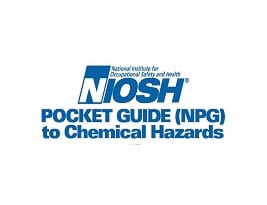Ozone
Overview
CAS No. 10028-15-6
Ozone (O₃) is a colorless to blue gas with a pungent odor. Exposure to ozone may cause headaches, coughing, dry throat, shortness of breath, a heavy feeling in chest, and fluid in the lungs. Higher levels of exposure can lead to more severe symptoms. Chronic exposure may lead to asthma. Workers may be harmed from exposure to ozone. The level of exposure depends upon the dose, duration, and work being done.
Ozone is used in many industries. It is used for purifying air and drinking water, in industrial waste treatment, oils, bleaching and waxes, and to make other chemicals. Some examples of workers at risk of being exposed to ozone include the following:
- Outdoor workers in areas with high levels of ozone
- Factory workers in paper and pulp mills
- Workers in waste water treatment plants
- Fisheries workers who treat storage water
NIOSH recommends that employers use Hierarchy of Controls to prevent injuries. If you work in an industry that uses ozone, please read chemical labels and the accompanying Safety Data Sheets for hazard information. Visit NIOSH’s page on Managing Chemical Safety in the Workplace to learn more about controlling chemical workplace exposures.
The following resources provide information about occupational exposure to ozone. Useful search terms for ozone include ” triatomic oxygen.”
NIOSH Chemical Resources
Related NIOSH Resources
- NIOSHTIC-2 search results on Ozone—NIOSHTIC-2 is a searchable database of worker safety and health publications, documents, grant reports, and journal articles supported in whole or in part by NIOSH.
- Immediately Dangerous to Life or Health (IDLH) Value Profile: Ozone—NIOSH reviews relevant scientific data and researches methods for developing IDLH values.
- The Flight Crew Research Program at NIOSH—Resources that help scientists determine if flight crew environments put them at risk of adverse health effects and what measures are needed to reduce that risk.
- Occupational Safety and Health Guideline: Ozonepdf icon
- CDC Outdoor Air – Air Contaminants: Ozone
- OSHA Chemical Sampling Information: Ozoneexternal icon
- New Jersey Hazardous Substance Fact Sheets: Ozonepdf iconexternal icon
- EPA Chemistry Dashboardexternal icon
- EPA: AirNowexternal icon
- EPA Good Up High, Bad Down Low: Ozoneexternal icon
- EPA Air Quality Guide: Ozonepdf iconexternal icon
- EPA: Ozone and Your Healthpdf iconexternal icon
- EPA: Ozone Generators that are Sold as Air Cleanersexternal icon
- NLM Hazardous Substance Data Bank: Ozoneexternal icon
- NLM Haz-Map: Ozoneexternal icon
- NLM Medline Plus: Ozoneexternal icon
- OSHA Hazard Communicationexternal icon
- International Safety Cards WHO: Ozoneexternal icon
- Canadian Centre for Occupational Health and Safety (CCOHS): Search results for Ozoneexternal icon
- European Chemicals Agency (ECHA): Ozoneexternal icon
- Gestis Substance Databaseexternal icon
- International Program Chemical Safety (IPCS) INCHEM
- OECD Global Portal to Information on Chemical Substances




